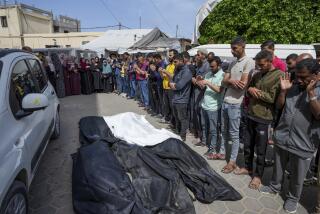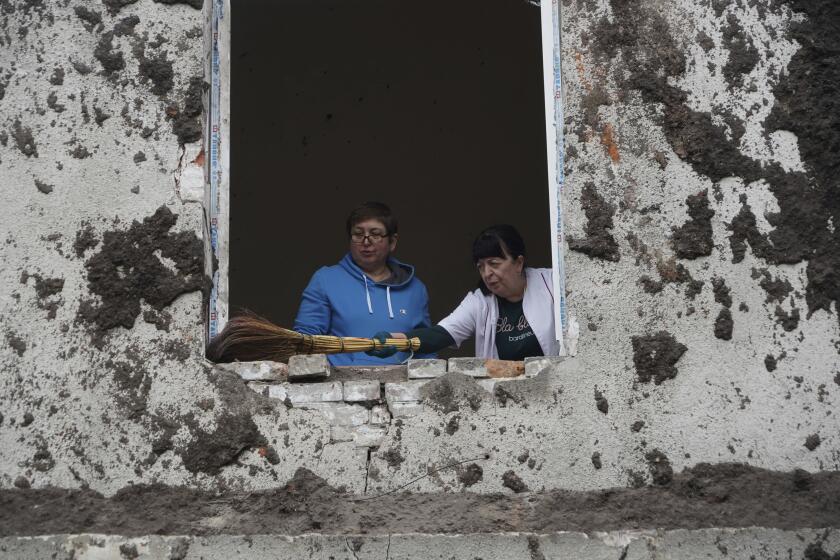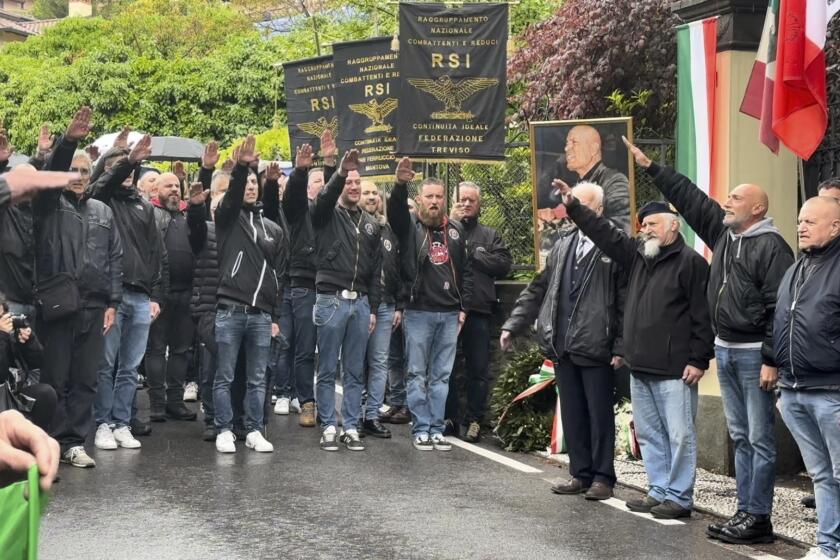Analysts Aimed Low to Score a Direct Hit
The groundwork for Saddam Hussein’s capture was laid several weeks ago, when frustrated U.S. intelligence analysts decided on a fresh approach.
Setting aside the most-wanted lists and the playing cards with mug shots of regime higher-ups, analysts from the CIA, the Defense Intelligence Agency and the military looked more closely at the lower ranks of Hussein’s network of supporters.
They went back through the roster of his security forces, recharted his family and clan connections, and reexamined the rolls of property owners in and around Hussein’s ancestral home of Tikrit.
They compiled fresh lists of Iraqis with the inclination and wherewithal to help the former dictator stay underground.
Then the military started rounding people up.
U.S. officials said the effort helped pry loose the tip that led soldiers to a remote Iraqi farmhouse where they found the elusive dictator hiding in a hole.
“As we continued to conduct raids and capture people, we got more and more information on the families that were somewhat close to Saddam,” said Army Maj. Gen. Ray Odierno, commander of the 4th Infantry Division, whose troops captured Hussein.
“Over the last 10 days or so, we brought in about five to 10 members of these families, who then were able to give us even more information,” he said.
The break in the nine-month pursuit of Hussein came Friday, when U.S. forces raided a safe house in Baghdad. By the next morning, a captured Iraqi had revealed to interrogators what Odierno called “the ultimate information” -- a rock-solid tip on Hussein’s whereabouts.
The lead pointed to two adobe farmhouses in the village of Ad Dawr, about 10 miles south of Tikrit along the Tigris River. At 10:50 a.m. Saturday, U.S. military commanders in Iraq began mapping out what they called Operation Red Dawn, though it was launched after dusk.
The farmhouses, in an area thick with orange, lemon and palm groves, were dubbed Wolverine I and Wolverine II. About 600 soldiers from the 1st Brigade Combat Team of the 4th Infantry Division, led by Col. Jim Hickey, were assigned to carry out the mission.
Known as the Raider Brigade for their experience in such operations, they included special forces, aviation units, cavalry, reconnaissance and artillery. They were told they were going after a “high-value target.”
“My guess is they probably did not know who it was until we were finished,” Odierno said.
The raiders moved into position about 6 p.m. Saturday; the operation began at 8. Failing to find their target in either of the farmhouses, they cordoned off a nearly two-square-mile area and launched a more intensive search, said Lt. Gen. Ricardo Sanchez, commander of allied forces in Iraq.
Upriver, they found a metal lean-to and a mud hut. Inside the hut were two rooms, one with a bed, chair and clothes strewn about, including new T-shirts. The other room was a crude kitchen with running water. The dwelling seemed to have been abandoned.
Suspicious, the soldiers moved a rug, uncovering what Sanchez called a “spider hole.” Its entrance was camouflaged with bricks and dirt. Underneath was a Styrofoam plug, light enough to be easily pushed aside from below.
The soldiers lifted the plug and uncovered a 6- to 8-foot-deep hole. At the bottom was a bleary-eyed man. His hair was long and tangled and he had a thick beard. He had a pistol but did not shoot. Hussein surrendered without resistance.
The once-mighty dictator had no security detail and only an empty taxicab waiting as a getaway car. U.S. forces found boats nearby on the Tigris, perhaps used by visitors to meet him, or to ferry in supplies or for a quick escape.
A search turned up $750,000 in packs of $100 bills, along with two AK-47 assault rifles. Two men who had tried to flee when the troops first moved in were also taken into custody.
Hussein was flown by helicopter to Baghdad. Despite his attempt at disguise, there was little question about his identity. Authorities took a DNA sample almost as a formality. Previously captured members of his inner circle, including former Deputy Prime Minister Tariq Aziz, were brought in to verify his identity.
For U.S. intelligence analysts and military commanders, the capture was a sweet conclusion to a frustrating pursuit.
When U.S. troops took Baghdad last April, Hussein was traveling in an entourage of luxury vehicles, surrounded by bodyguards and supporters. He was well dressed, well defended and seemingly oblivious of the forces arrayed against him.
In early May, a videotape obtained by Associated Press Television showed a bedraggled and confused-looking Hussein seated at a boardroom table in military uniform, reading from a prepared statement.
Thereafter, Hussein was a disembodied voice on audio-tapes, urging Iraqis to fight the “occupiers.”
Authorities believe he kept to the agricultural villages near the Tigris River, protected by a tight network of tribal and family loyalties.
At one point last summer, the 4th Infantry Division launched an average of 10 raids every 24 hours, some aimed at Hussein himself, others at his lieutenants. Nearly all of the raids were based on tips that poured in after U.S. authorities offered a $25-million reward.
On Aug. 21, a lead sent soldiers to a farmhouse owned by a Baath Party loyalist in the town of Abbarah. The troops took five men into custody but found no sign of Hussein.
In early September, soldiers swooped down on Albu Talha, a tiny village of mud huts and shepherds. The area was known as the ancestral homeland of Hussein’s mother, and a tip had suggested he was hiding there. Incongruously, the troops found CBS anchor Dan Rather instead, wearing a flak jacket and helmet and reporting from the Iraqi countryside.
Military authorities suspected their own planning, including scouting missions, was tipping off Hussein’s protectors, giving him time to escape. Odierno said his troops had previously been in the town where Hussein was discovered Saturday.
Despite their frustration, U.S. forces were steadily narrowing Hussein’s room for maneuver.
U.S. lawmakers and military officials said a number of recent changes had contributed to his capture. More intelligence analysts were sent to Iraq. Communications with the military were streamlined. Intelligence agents teamed with a special operations group dubbed Task Force 11.
And analysts shifted their focus from the most notorious of Hussein’s lieutenants.
It was “an effort to ... approach it from a different direction
Officials said it was significant that President Bush, in his nationally televised address on Hussein’s capture, singled out intelligence analysts for praise. “The operation was based on the superb work of intelligence analysts who found the dictator’s footprints in a vast country,” Bush said.
Solders traced those footprints to an apparently deserted farmhouse by the river and found their quarry beneath a rug and a foam lid, six feet underground, and took him alive.
*
Miller reported from Washington and McDonnell from Tikrit.
More to Read
Start your day right
Sign up for Essential California for news, features and recommendations from the L.A. Times and beyond in your inbox six days a week.
You may occasionally receive promotional content from the Los Angeles Times.






